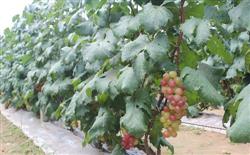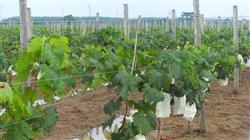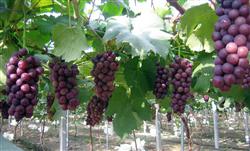Grape planting techniques: how to trim Fujiminori grapes in summer?

How to trim Fujiminori grapes in summer? Please introduce the method of Fujiminori grape summer pruning can refer to the following methods: 1 wiping buds and fixed shoots after sprouting in spring, erasing weak buds and useless hidden buds or twin buds and triple buds. In order to avoid the waste of nutrients, early sprouting time is suitable, and when the new shoots grow 10-15cm, the shoots can be fixed. When the new shoot grows above 10cm, the extra twigs are removed, which is called thinning. From wiping buds and fixing shoots, sprouts should be wiped 2-3 times. The number and degree of fixed shoots should be determined according to tree age, tree potential, cultivation and management conditions and the number of buds retained during winter pruning. The buds in the trunk or main vine within the ground 40cm should be completely erased at the initial stage of germination, and the buds on the other mother branches should be wiped off after about 10 days of sprouting or over-dense buds. In principle, go to the growing branch and leave the fruiting branch, remove the weak branch and leave the strong branch, remove the injured and diseased branch and leave the normal branch, and go up and pull the branch to leave the place branch. (2) the treatment of coring and secondary shoots is to remove 3-5 tender tips of new shoots, which aims to inhibit the growth of vines, save nutrients, promote flower bud differentiation and vine ripening, and improve the yield and quality of Fujiminori grape. Heart picking is carried out before flowering to the period when the new shoots stop growing. The coring of fruiting branches is usually carried out 3-7 days before flowering or in the early stage of flowering. It is appropriate to leave 5-7 leaves above the inflorescence to pick the heart, and the fruiting branches with few leaves and weak growth can not be picked for the time being. It is appropriate to leave 10-15 leaves for vegetative branches, which is generally later than that for fruiting branches, and 12-20 leaves for extended branches, which is later. The stronger secondary shoots above the inflorescence can leave 4-5 leaves to pick the heart, and the weaker ones can leave 1-2 leaves to pick the heart. After the coring of the accessory shoots, the coring of the accessory shoots will be removed repeatedly throughout the growing period, usually once every 10 seconds and 15 days, about 4-6 times a year, and stop plucking when the fruit is colored. (3) thinning inflorescence, pinching inflorescence tip and spike shape should be carried out 2 weeks before flowering. Generally, there are 2 inflorescences in strong branches and 1 inflorescence in weak branches. Pinch the tip of the inflorescence, that is, pinch off the end of the inflorescence 1 / 3 or so, and pinch off the accessory ear. When the fruiting branches are thin or lack of fertilizer and water, they should be more sparse and heavy thinning inflorescences. One week after flowering, the fruit was thinned and arranged in ear shape, and the small fruit was removed, leaving 25-30 fruits per ear. (4) removing tendrils and binding new shoot tendrils is not only a waste of nutrients, but also appropriate to wrap around ears and branches, affecting the normal growth and development of ears and branches, which should be removed in time. When the length of the new tip reaches 20-40cm, it is necessary to do a good job of binding the new tip, which can be divided into horizontal binding, vertical binding, oblique binding and bow binding. Horizontal and bow binding can inhibit the growth of new shoots and enrich the basal bud eyes, which are mostly used for fruiting and developing branches, while vertical and oblique binding are mostly used for lengthening branches and weaker branches. The main vine of a fan-shaped pruning of a hedge, which can be tied vertically or obliquely; one arm that is pruned horizontally, can be tied horizontally. When binding new shoots, be careful not to bind the vines too tight, leaving some leeway to facilitate thickening growth. (5) picking leaves in the late stage of ear ripening, properly removing some of the old leaves which have lost their function can improve the light and ventilation conditions of the plant, facilitate ear coloring, increase fruit value, and cut off the excessively long autumn shoot tip and add 20-30cm. The summer pruning measures of Fujiminori grape must be closely coordinated with variety characteristics and cultivation management techniques in order to achieve good results, but it is difficult to achieve the desired results if only emphasizing a certain technology. Click to get more grape planting techniques click to get more fruit planting techniques
- Prev

Grape planting techniques: what are the diseases of summer grapes?
What are the diseases of summer grapes? Please introduce and introduce the control methods of grape planting in summer, especially the prevention and control of black pox, white rot, anthracnose and downy mildew. Give priority to prevention and spray in time. For drugs with a residual period of 17 mi for 21 days, they are generally sprayed every 15 days.
- Next

Grape planting techniques: how to fertilize the grapes to make them sweeter?
How can fertilizing make grapes sweeter? Please introduce the method of fertilization in order to make the grape sweeter, you can refer to the following fertilization methods: first, pay attention to the base fertilizer around October, that is, the end of autumn is the best time for grape to apply base fertilizer. When applying base fertilizer, we should pay attention to the combined application of organic fertilizer and microbial fertilizer, using rot per mu.
Related
- Moge, come on! The staff of the peasant association in the producing area of cantaloupe were frightened when the crowd gathered.
- Causes and Solutions of low Fruit setting rate of Apple
- Symptoms and control measures of passion fruit virus disease
- Fruit growing lesson: how do apple orchards keep high yields?
- Can you build orchards in the mountains? What are the pros and cons?
- How to manage the coloring period of Crisson grape?
- This paper introduces the processing technology of two kinds of fig products.
- How much is a month for retired teachers in rural areas by 2020?
- How can strawberry planting increase sugar content? We should pay attention to management in many aspects.
- What are the cultivation techniques on how to improve the yield of golden fruit?

